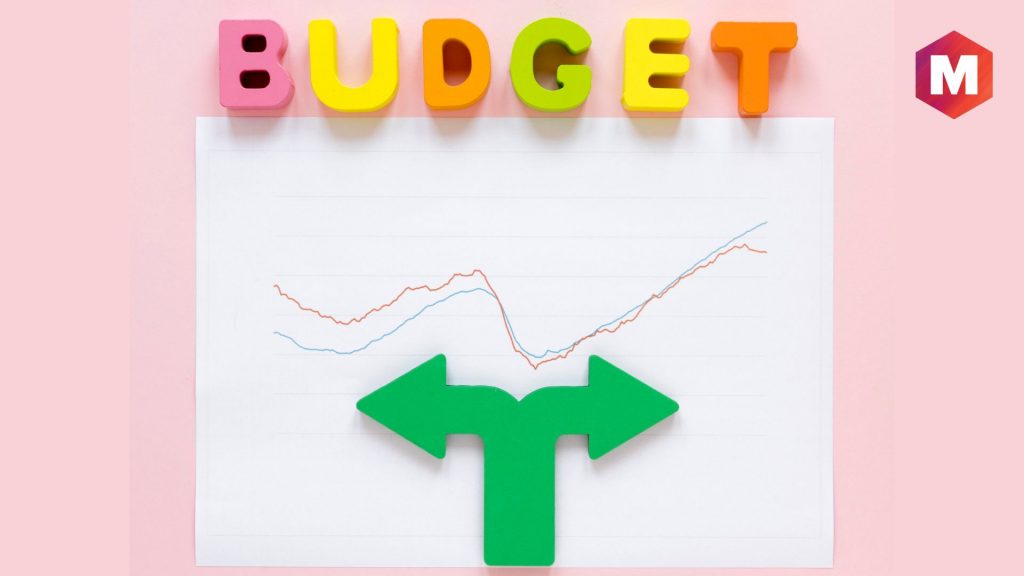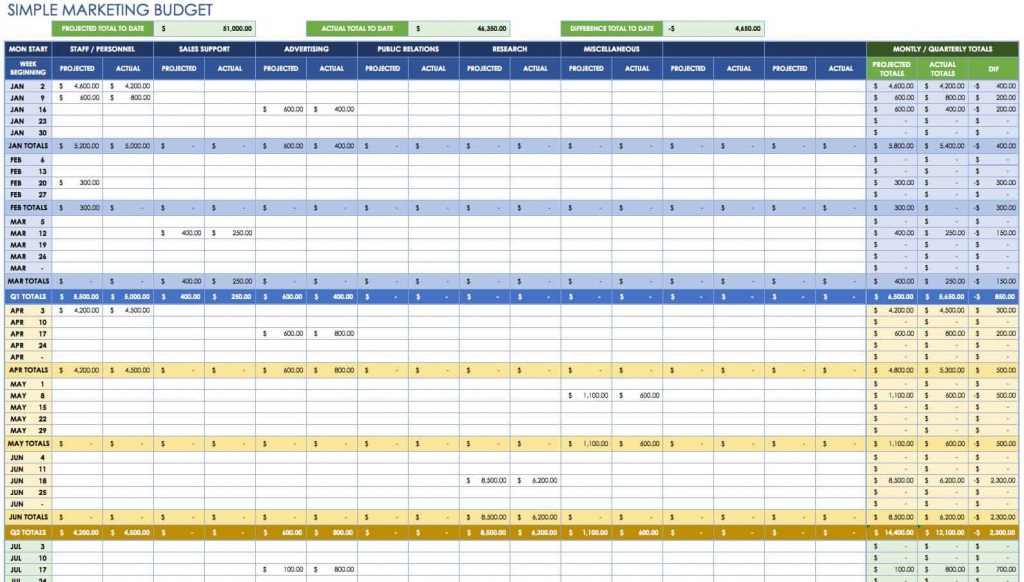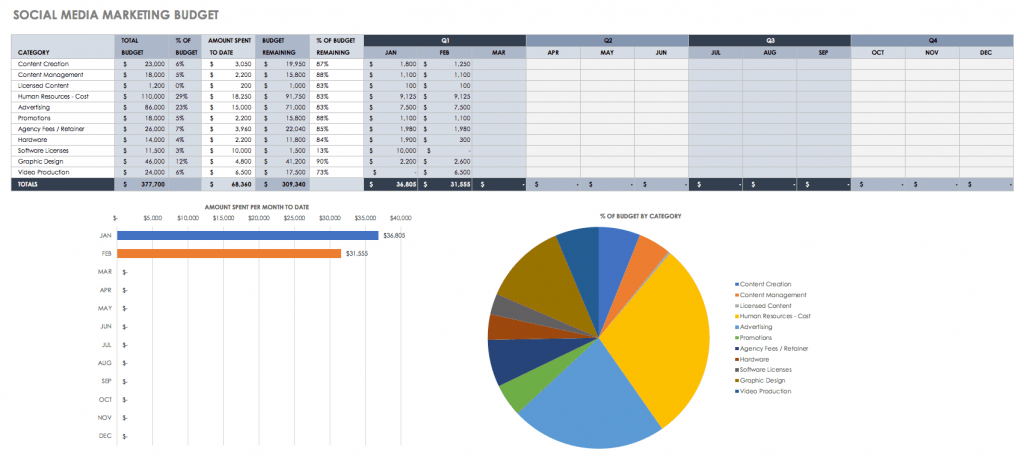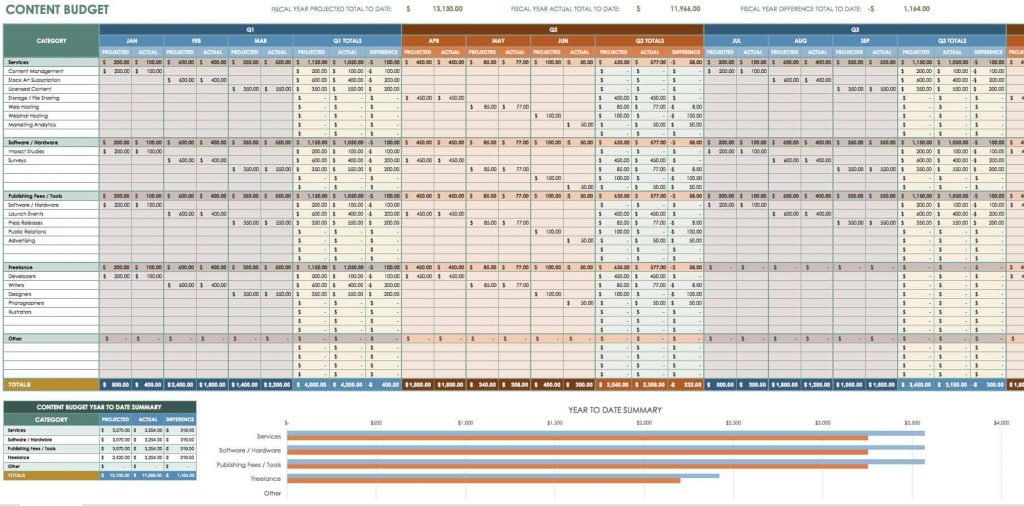Any firm looking to increase brand awareness needs a precise marketing budget. Well-planned marketing budgets provide the advertising and promotional tools you need to boost your market position.
Your marketing budget should be tailored to your business’s needs, sales goals, and goals for maximum performance. Monitoring and evaluating your initiatives enables data-driven adjustments, ensuring optimum marketing results.
In this article, we will walk you through marketing budget management from start to finish and provide templates to help you get started.
Key Takeaways:
- Creating a specific marketing budget is critical for increasing brand awareness.
- A well-planned budget provides the essential resources for advertising and marketing.
- Budget allocation should be customized to the company’s specific requirements and goals.
- Continuous monitoring and assessment enable data-driven modifications.
- The article provides a complete guide on managing marketing spending.
- Templates are supplied to help the planning process run more smoothly.
Table of Contents
What is a Marketing Budget?
A marketing budget is a spending plan that outlines the funds allocated for promotional activities in a given period. Strategic marketing budgets are essential for maximizing return on investment.
It’s vital to consider where you should allocate your funds, how much to spend on each type of promotion, and if it fits into the greater scope of your marketing strategy and brand image. Therefore, it is essential to use your marketing budget wisely, which can involve marketing costs associated with –
- Traditional & digital marketing channels
- Investing in paid advertising
- Creating sponsored digital content
- Hiring new personnel with a background in marketing
- Using CRM
- SEO
- Social media marketing
- Inbound marketing, etc
Why do you need a marketing budget?
A marketing budget is vital for any successful business. It helps you keep your market share and earn more. A budget for advertising your company and products displays your income. You must adequately promote your brand to attract, educate, and sell. Doing this well can yield big profits. You need a marketing budget for this.
It is critical to manage your finances wisely. You must stick to a strategy and use only what you have. This will keep your business running smoothly. A budget for advertising can help you achieve both short-term and long-term objectives. If firms do not plan adequately, they cannot cover costs and earn profits, leading to a negative perception of the organization.
Now that you understand the need for a marketing budget let’s discuss how you might spend it. The following section will help you understand the costs of spreading the word about your company.
Types of Marketing Expenses
Understanding the importance of various marketing budgets can greatly assist your organization. It allows you to deploy dollars and optimize your marketing plan efficiently. Let us look at the key characteristics of marketing expenses to incorporate into your business:
- Publicity efforts: To reach and engage your target audience, use various advertising strategies, including pay-per-click, social media ads on platforms like LinkedIn, Twitter, and Snapchat, email marketing, and traditional methods (newspapers, TV, radio, and billboards).
- Occasions: Invest in event planning that requires cash for food, décor, photography, marketing, equipment, entertainment, location, and so on to launch goods, showcase features, or celebrate milestones, thereby increasing customer and partner involvement.
- Branded Merchandise: Distribute promotional goods with your logo, such as bags, stationery, or clothing, to increase visibility and foster natural brand advocacy.
- Digital Resources and Software: To manage customer relationships effectively, use specific technology and tools for visual design, web development, and complete marketing platforms like CRM systems.
- Equipment: Purchase specialist tools such as laptops, smartphones, cameras, and audio-video production equipment specific to your marketing goals, such as podcasting.
How much should a company spend on marketing?
Marketing costs depend on your business’s industry, size, and growth. A percentage of your company’s revenue is a good marketing budget estimate. Before investing in marketing, consider your business goals, operating costs, and growth aspirations.
Let us examine how these factors differ by company growth stage:
1. High Growth (Startup)
In a rapidly rising phase, such as that experienced by startups, the rate of expansion must be swift; otherwise, competitors may grab market share. In such a case, allocating 15% to 30% of anticipated income on marketing is advisable.
For example, a seed-funded business should plan to spend 30% to 50% of its raised funds on marketing campaigns. If an entrepreneur hopes to achieve an Annual Recurring Revenue (ARR) of $100,000, he or she should budget between $10,000 and $40,000 for marketing campaigns.
2. Moderate Growth
When a company is experiencing moderate growth, it is critical to increase its marketing budget to compete with its industry counterparts. While the actual budget depends on the company’s nature, allocating 10% to 15% of total revenue to marketing efforts is frequently a fair bet.
For example, a company with $2 million in revenue should prepare to invest between $400,000 and $500,000 to accelerate its growth.
3. Stable Growth
Established organizations with consistent growth typically have access to large marketing expenses. Concurrently, they gather information that instructs them on how to make effective marketing investments, allowing them to better control their marketing costs. To maintain their market positions, these firms often set aside 2% %- 10% of their income for marketing activities.
Sample marketing budget breakdown
Taking a closer look at marketing expenses, consider this typical allocation of the marketing budget:
1. Content Marketing (30-40%)
This includes all costs associated with creating and publishing relevant material such as blog articles, ebooks, case studies, infographics, social media tools, etc. Content marketing investment directly impacts the quality and efficacy of your brand’s communication.
2. Paid advertising: 20-30%
Paid advertising is an effective way to increase brand awareness and drive visitors to your website. It can range from traditional to digital ads, which provide instant ROI measurements.
3. Creative design and branding: 5–10%
These include all expenses such as printing, software, employing experts, etc. Strong design and branding set your company apart from competitors and make your marketing more appealing.
4. Public Relations and Events: 5–10%
These would include charges for actions meant to increase your brand’s visibility, such as attending industry events or managing your brand’s reputation.
5. Analytics: 2–6%
Investing in analytics tools or services allows you to turn corporate data into actionable insights and make informed decisions.
6. Tools and Software: 10%
These utilities improve your efficiency by automating enjoyable activities and offering performance metrics. Costs typically include membership costs for tools such as marketing automation, CRM, and email marketing platforms.
7. Staff Members: 10%
This comprises expenses such as salary, training, benefits, and other staffing requirements. It is a necessary investment to keep and develop a devoted and motivated marketing workforce.
How much do small businesses spend on advertising and marketing?
The amount of money that small businesses spend on advertising and marketing can differ drastically depending on their target market, industry sector, product, or service.
- The U.S. Small Business Administration recommends that profitable businesses with yearly sales under $5 million allocate 8% of their total earnings to marketing expenditures to achieve optimal results.
- Digital media has become the primary source of advertising expenditures both in the U.S. and around the globe, comprising over fifty percent of overall spending on ads. This encompasses campaigns tailored to consumers who use desktop computers, search engines, video streaming services, social networks, mobile devices, etc.
It is critical to strategize when assigning marketing budgets to get the most out of your expenditures and ensure optimal results.
Marketing Budget Breakdown
Generally, businesses set aside between 7-10% of their total revenue for marketing purposes.
If you’re unsure where to begin with your budgeting plan, the standard guideline many use is the 70-20-10 rule. This will provide you with an excellent benchmark from which to start:
- Invest 70% of your budget in tactics that have already proven successful.
- Set aside 20% of your budget to invest in innovative strategies that will take your business to the next level.
- Set aside 10% of your budget to try out innovative strategies.
Some of the other ways that can help you in breaking down your marketing budgets are-
- Revenue-based: Review your annual revenue figures and allocate a percentage to decide on a marketing budget. Generally speaking, businesses ought to invest between 6.5% and 8.5%. But if you are starting or have been operating for less than five years, allot 10-12% towards marketing efforts instead, as this is ideal for newer ventures.
- Competition-matched: By leveraging existing research, you can also plan a budget that is in line with what your competition is investing in.
- Top-down: With a top-down budgeting system, there are no pre-assigned calculations of how much to spend per quarter or year. Rather, management establishes the amount and entrusts the marketing division to stay within those limits.
- Goal-driven: Prioritizing objectives over a budget, goal-driven marketing initiates with management and marketing identifying the desired outcomes before allocating resources to realize them. For instance, businesses seeking to maximize website traffic should invest their budget in strategies that expand visibility and reach.
Marketing Costs to Consider in a Marketing Budget Allocation
Some of the key marketing costs you should pay heed to while allocating marketing budgets are:
1. Software
If you’re looking to make a splash with digital or print media, the right software can be instrumental in helping you design successful marketing campaigns and streamline your daily operations. You can find tools or software for almost all types of marketing activities-
- Customer relationship management (CRM)
- Lead capture and lead generation
- Marketing automation
- Conversion rate optimization
- Social media optimization and marketing
- Online advertising
- Digital asset management
- Event marketing
- Email marketing
- Content creation and design
- Team collaboration
- Data reporting and analytics, etc
Their charges may vary, so research and pick the best one for your needs. Small business owners need to make prudent marketing investments in such tools to empower marketing strategies and optimize company revenue.
2. Freelancers
If you only need assistance for a very specific project or to test out a fresh marketing strategy, hiring a freelancer on a short-term basis can be the ideal choice before committing to bringing someone on board as an employee. Before hiring a freelancer, you must astutely assess your budget, as they often charge by the hour.
3. Full-time Marketing Personnel
If you choose to onboard full-time employees, consider that there are associated costs such as computer hardware, technology needs, benefits, and training. Industry research reveals the typical cost per employee is a hefty $4,425!
4. Advertising
To ensure you stay within your budget, allocate the right amount of money for paid opportunities such as physical ads, native ads, sponsored content, search engine advertisements, and social media promotions.
5. Content Creation
Crafting content for your blog, photo gallery, or video channel requires significant hard work and dedication. Content marketing has the potential to generate three times more leads than traditional strategies, so investing funds in this venture is worthwhile. Make sure you designate an appropriate budget for content creation, as it will allow you to evaluate its ROI and modify your approach if necessary.
How to create a marketing budget?
If you want to create a successful marketing budget, be sure to follow these useful steps –
1. Find out your marketing goals
- Crafting an effective marketing budget requires strategic thinking about short-term and long-term goals and setting KPIs (Key Performance Indicators) that align with your vision.
- By building a sales funnel or generating direct sales, you can increase gross revenue while making sure your money is spent wisely so it’s worth the investment.
- Short-term goals can be decreasing bounce rate, increasing average time on page, and increasing website visits.
- An ambitious long-term plan may involve launching a new product, creating an exclusive loyalty program, or increasing brand awareness.
2. Understand your target audience (buyer personas)
- Crafting a buyer persona can be extremely useful when identifying your ideal customer. For example, a startup’s marketing budget will vary according to the target demographics for a specific marketing campaign.
- Remember to incorporate ethnicity, age, gender, job title, income level, and profession, among other qualities, to guarantee dependable representation and precision in data-driven decisions.
- Possessing a precise buyer persona is essential in constructing the correct marketing budget. You can do it by surveying your current customers, using analytics tools, or interviewing your potential customers.
3. Know your buyer’s journey
- The buyer’s journey is your target audience’s path to becoming a paying customer.
- By understanding how they interact with your marketing, you can uncover effective methods to reach and convert customers and set achievable budgeting goals.
- Knowing your buyer’s journey means more efficient campaigns that bring results.
- You can do this by asking questions like how your leads and customers find your products, what information your audiences need before making a purchase, the ratio of lead generation to conversion, etc.
4. Understand your market and competition
- By learning more about your customer’s demographics through market research, you can gain an in-depth understanding of your target audience.
- To understand the market better, you can analyze their general demographic information, influencing factors, wants and needs, etc..
- To better understand the competition, observe their tactics for connecting with customers and identify how their approaches differ from your own.
- By understanding how your competition spends its marketing budget, you can identify and take advantage of market gaps to quickly establish yourself as a competitive player.
5. Choose your marketing channels
To get the most out of your marketing budget, it’s essential to target those areas where your buyer personas are spending their time. Four fundamental channels will help you in achieving this goal-
- Online Marketing – Social media strategies, Search Engine Optimization, Digital Advertising, Social Media Ads, Website Marketing, Search Engine Marketing Initiatives, etc
- Traditional Marketing – Radio, Newspapers, Out-of-Home Advertising
- Inbound marketing – Content Marketing, Referral Marketing
- Outbound marketing – Cold Calling, Direct Mail, Traditional Advertising.
- Brand awareness campaigns – Focus on improving brand visibility and recognition.
6. Set Marketing Goals & Analyze Results
- Achieving success begins with having clear goals.
- Before deciding on your budget, construct a timeline of specific, quantifiable ambitions, such as augmenting organic traffic or achieving a set number of app downloads.
- To monitor progress systematically, install analytics tracking and tools for your marketing campaigns.
7. Measure ROI
- Tracking your marketing ROI is essential for ensuring you use your marketing spend efficiently. When you pay close attention to which channels or campaigns bring the best results, it becomes easier to identify what needs improvement. Then, you can adjust your average marketing budget accordingly.
- By regularly refreshing and optimizing your budget based on performance data, you can ensure that every dollar invested in advertising yields maximum returns.
How to track your marketing budget
Tracking marketing budgets can be daunting, and there is no one-size-fits-all solution. Factors such as your industry, your marketing spend, and your business size need to be considered when crafting a comprehensive approach that works for you. The following ways can help you in tracking your marketing budget –
- Campaign tracking: To better organize your campaigns, create a single line item for each that includes the campaign name and expenditure. Additionally, all staff salaries and the time required to complete every campaign must be noted accurately. Finally, keep track of any necessary changes or adjustments related to both time and cost.
- Lead tracking: For each lead, add a line item of information that includes the date acquired, origin source, advertisement or campaign used to attract it, assigned sales representative name and contact details, any relevant notes pertinent to the lead’s progress, current status, and total revenue generated.
Marketing Budget Templates
To give you a helping hand, consider utilizing a marketing budget template. Some of the Smartsheet marketing budget templates that you can use are-
1. Simple Marketing Budget Template
This streamlined marketing budget template lets you compare projected and annual costs for multiple categories side by side. You can assign expenses every week of the month to keep an eye on your total outlay over periods of one month, three months, or a year – whichever is most convenient to you!
2. Social Media Marketing Budget Sample
With this free marketing budget template, Keep tabs on your social media expenditures, from personnel and agency expenses to content production or campaigns.
3. Content Marketing Budget Sample
No matter the scope of your content marketing strategy, having a budget that accounts for expenses such as freelancers, stock images, publishing tools, video hosting services, and analytics is essential. This comprehensive budget template enables you to calculate costs on a monthly or quarterly basis and forecast yearly expenditures.
Common marketing budget mistakes
In the complex marketing budget allocation world, it is easy to fall into traps that can undermine the efficacy of your marketing activities and risk your financial health. Here, we will look at typical budgeting traps and offer tips to help you manage them more effectively.
1. Allocating Insufficient Funds to Proven Strategies: Organizations invest in old techniques out of habit, even when emergent channels work better. As tempting as it is to stick to what works, the market evolves.
Previously profitable tactics may suddenly lose money. To stay current in the consumer market, invest in classic and cutting-edge methods. If digital marketing or content development seems promising, invest.
2. Ignoring the Importance of Clean Data: Choosing a marketing strategy without a good grasp of your target demographic is like navigating without a compass. To create advertisements that resonate, it is critical to use reliable, up-to-date consumer data.
Erroneous data can confuse your approach, spending valuable resources on unproductive initiatives. Regularly audit your data for accuracy, deleting any wrong information that could result in costly mistakes.
3. Overlooking Existing Consumers: Attracting new consumers is often prioritized over retaining existing ones. Growing your client base is crucial, but disregarding old customers is costly. Starting a new relationship is more expensive than maintaining one. Focusing on customer retention through loyalty programs or targeted marketing can boost ROI.
4. Using past budgets without reflection: Using the previous year’s budget as a guide ignores the market’s volatility. Consumer preferences, cultural changes, and technological advances can all affect past attempts.
Start each budgeting cycle with a new assessment of the circumstances and company goals in light of new developments. To find new marketing opportunities and keep up with technology, societal trends, and economic changes.
Create a Strategic Marketing Budget that Propels You Toward Your Goals!
A key component to success is establishing a marketing budget that will cater to your business goals. Whether those are aimed towards promoting brand visibility or propelling more sales and leads, it’s essential that you realistically assess how much can be spent on the campaign and where these funds should ideally be distributed.
Suppose you invest the time to evaluate your current scenario, establish goals, research your target market, and analyze the competition. In that case, you can craft a strategic marketing budget to help you achieve those objectives.
Liked this post? Check out the complete series on Marketing



